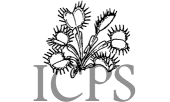|
Carnivorous Plant Newsletter
Volume 43, Number 1, March 2014, pages 23 - 28
New Cultivars
Dionaea muscipula ‘Kayan’
Dionaea muscipula ‘Phoolan Devi’
Drosera x californica ‘Portland Sunrise’
Sarracenia ‘Black Jaw’
Sarracenia ‘Black Mamba’
Sarracenia x moorei ‘Silvia Luise’
Sarracenia x moorei ‘Silvia Luise’
Submitted: 13 October 2013
Sarracenia × moorei ‘Silvia Luise’ is a Sarracenia × moorei that I made in 2008 by crossing a
copper tinged S. flava var. rugelii with a typical form of S. leucophylla. This plant has the same color
and shape of S. leucophylla, except for a very bright pink patch on the “neck” of the pitcher. It is
different from similar clones of S. × moorei having a pink neck because of the particular coloration:
there is not one big pink blot on the neck, but there are two patches divided from the central nervation
of the leaf that is white, as is the rest of the pitcher (Fig. 1). The adult plant is about 70-80 cm
tall with pitchers 4-5 cm wide. The flower is light red/orange. In spring, it produces smaller and not
very colorful pitchers.
I named this cultivar Silvia Luise in September 2010 as a dedication to the most important
woman in my life, my friend, and my girlfriend.
Sarracenia × moorei ‘Silvia Luise’ must be reproduced vegetatively to preserve the characteristics
of the cultivar.
—Daniele Righetti • 20127 Milano • Italy • flava-rugelii@hotmail.it
 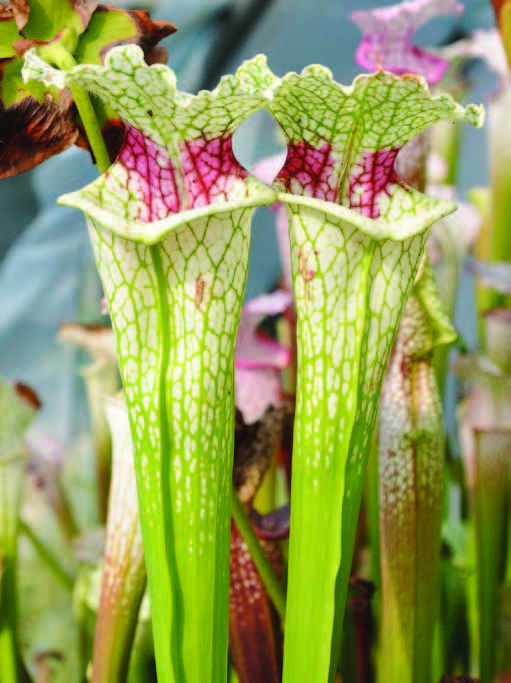
Figure 1: Sarracenia × moorei ‘Silvia Luise’ pitchers.
Sarracenia ‘Black Jaw’
Submitted: 17 November 2013
Sarracenia ‘Black Jaw’ is a hybrid (Sarracenia rubra subsp. gulfensis × S. leucophylla) × (S. leucophylla × S. rubra). The pitchers grow vertically. The rhizome has a horizontal spread. The upper part of new pitchers is green/pink with white areolas, becoming pink with pink veins and white areolas as they become older (Fig. 2). The pitcher opening becomes increasingly dark red with a silky black border inside the operculum – the most important feature of this cultivar. The areolas eventually turn a deep pink color. The operculum is points upward with jagged edges. Veins are evident only in the juvenile stage, and then become the same red color of the upper part of pitcher. The maximum pitcher height is 60 cm and the width is 4.5 cm at the lip. The back of the operculum merges with the pitcher. The pitcher exterior is pubescent.
I coined the name ‘Black Jaw’ in September 2013 because the persistent characteristic black color around the lip of the pitcher's mouth and in the inner side looks like it has a black jaw.
Cultivation is the same as with other Sarracenia. This hybrid is winter-hardy; it has survived -5°C without damage. Vegetative propagation is necessary to maintain the unique features.
—Stefano Lascialfari • 50137 Firenze • Italy • steno79@inwind.it
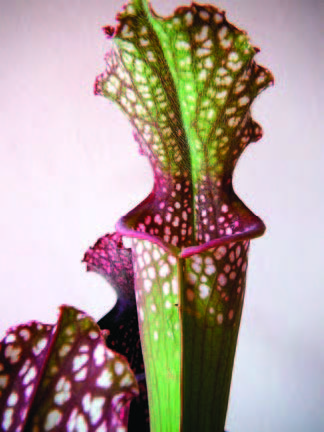 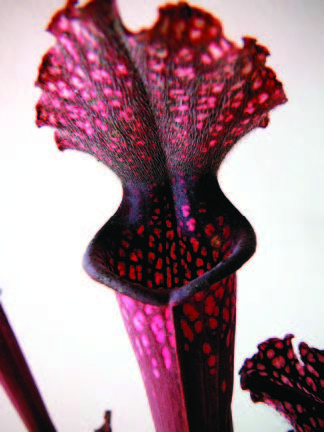 
Figure 2: Sarracenia ‘Black Jaw’ early, middle, and late pitchers (left to right).
Sarracenia 'Black Mamba'
Submitted: 22 September 2013
Sarracenia 'Black Mamba' is a hybrid of S. leucophylla "red & white (L23MK)" × S. alata var. nigropurpurea "stocky pubescent, De Soto National Forest (A28MK)". Both parents are originally from Mike King. Sarracenia 'Black Mamba' was created by Vincenzo Castellaneta who gave the plant to me in September 2012.
I grew my plant for 12 months to see if its characteristics were stable under growing conditions different from those of the hybridizer. This spring, the plant emerged from dormancy and, to my delight, the distinguishing features were identical to those observed a year ago.
Sarracenia 'Black Mamba' has a rhizome colored with anthocyanins. The pitcher is erect without folds as it develops. Early pitchers are initially green and light red (Fig. 3a). The growing pitcher begins to form many fenestrations from a few centimeters below the lip to the neck. Two red spots, well separated from fenestration, can be seen on the sides of the neck within the pitcher opening above the operculum. Abundant dark red veins extend to the middle of the pitcher (Fig. 3b).
After a few days in the sun, the underside of the operculum, neck, lip, and throat begin to darken more and more each day, until it becomes a very dark red, appearing almost black (Fig. 3c). The pitcher is pubescent and produces a good quantity of nectar.
This cultivar is named because at first glance it looks like the mouth of a “black mamba” snake trying to bite its prey — in fact, the inside of the mouth of this dangerous snake is very dark.
Sarracenia 'Black Mamba' must be reproduced vegetatively to preserve the characteristics of the cultivar.
—Sonia Ibelli • 56127 Pisa (PI) • Italy • sonia80pisa@libero.it
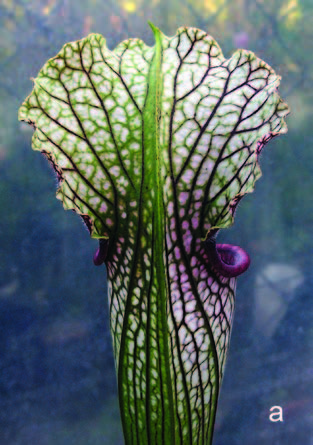 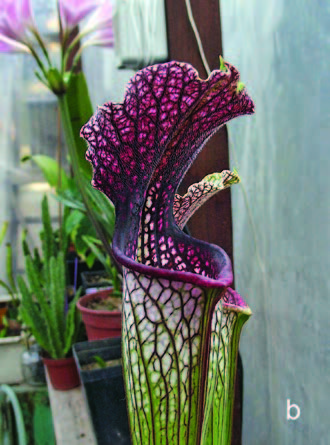 
Figure 3: Sarracenia 'Black Mamba' early pitcher (a, b) and late pitcher (c).
Dionaea muscipula ‘Phoolan Devi’
Submitted: 23 November 2013
Dionaea muscipula ‘Phoolan Devi’ is a white Venus Flytrap. In spring, the leaves are green and then they turn white during summer (Fig. 4). Discovered in 2009, this plant has been called by the unregistered local name Dionaea muscipula “Pâle”.
I selected the name for Phoolan who was born in rural India, in a poor family belonging to the Mallaah caste. Married to a much older man at an early age, she was branded as a social outcast after she left her husband to escape marital mistreatment. A family feud resulted in her arrest and made her a victim of police brutality, which greatly embittered her. She was kidnapped by a gang of bandits, who had been paid to kill her. Subsequently, she married one of them, Vikram Mallah, who protected her from a rape attempt by the gang leader, and became part of the gang. With Vikram as the new leader of the gang, the group punished Phoolan's ex-husband, and carried out several robberies. Later, a group of bandits belonging to the Thakur upper-caste murdered Vikram and gang-raped Phoolan. After escaping from their captivity, she raised a Mallah-dominated gang, which carried out a series of violent robberies. She gained a fearsome reputation as the "Bandit Queen", and some villagers started calling her an incarnation of the Hindu goddess Durga. Some people saw her violence as the lower castes' retaliation against the cruelty of the upper-castes. In 1983, she surrendered and was sent to prison for 11 years. After her release, she contested elections as a candidate of the Samajwadi Party, and was elected to parliament in 1996. On July 25, 2001, she was shot dead outside her home by masked men from upper-caste.
When she was a little girl, Phoolan used to climb in a very big Neem tree (Azadirachta indica) and the flowers of this tree are pure white with some yellow green darker color in the center. So it reminds me of this Dionaea and I give it the name of this amazing woman.
—Guillaume Bily • 56700 Kervignac • France • gbily2003@yahoo.fr
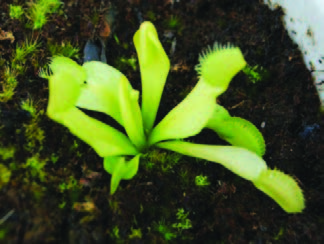 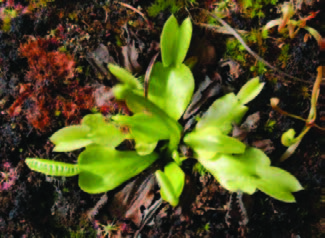 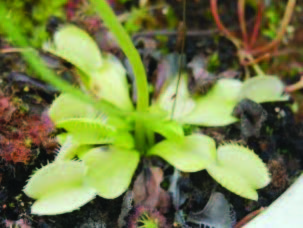
Figure 4: Dionaea muscipula ‘Phoolan Devi’ in early spring, middle spring, and summer (left to right).
Dionaea muscipula ‘Kayan’
Submitted: 23 November 2013
Dionaea muscipula ‘Kayan’ is a Venus Flytrap with a very long neck that can reach 2.5 cm between the leaf and the trap (Fig. 5). The neck (petiole) may be similar in Dionaea ‘Crested Petioles’, but in this cultivar the neck is not always as elongated as in D. ‘Kayan’. Another plant with a long neck is Dionaea ‘Trichterfalle’, also known as ‘Funnel Trap’, but this cultivar has cupped traps.
The Kayan are a subgroup of the Red Karen (Karenni) people, a Tibeto-Burman ethnic minority of Burma (Myanmar) in Northern Thailand. In this group women wear the brass neck coils and their neck is very long. So when I selected the name for this new cultivar I thought about those women and the name of their tribe.
—Guillaume Bily • 56700 Kervignac • France • gbily2003@yahoo.fr

Figure 5: Dionaea muscipula ‘Kayan’.
Drosera × californica ‘Portland Sunrise’
Submitted: 27 September 2013
Drosera × californica ‘Portland Sunrise’ (Fig. 6) is an apparent hybrid between Drosera filiformis and Drosera tracyi that resembles D. filiformis more than the horticultural hybrid Drosera × californica ‘California Sunset’ (Robinson 1981). The exact history of the plant is not known. In 2006 or 2007, Djoni purchased a plant labeled “Florida Giant Dewthread” from a vendor at the Portland Saturday Market and planted it in her backyard bog. She was told it was sterile. After a few years it spread to a large area in her bog via seeds (Fig. 7). Upon further investigation and comparison with another plant purchased from the same vendor at the Portland Saturday Market in 2012, she found that her plants were redder and shorter than expected for Drosera filiformis “Florida Giant” (D’Amato 1998), the plant name specified on the original label. The flowers are typical of Drosera × californica (Fig. 8), although they are smaller than those of Drosera filiformis “Florida Giant”. We have not compared them side-to-side with D. ‘California Sunset’. In 2013, when Djoni donated seeds from her plants to the ICPS Seed Bank, John queried her as to exactly what they were so they could be listed correctly. She sent him photos and some plants weeded out of her bog. We decided to list them as Drosera filiformis × tracyi while the plants were studied further.
The primary diagnostic difference between Drosera × californica ‘Portland Sunrise’ and both D. × californica ‘California Sunset’ and D. filiformis “Florida Giant” is the red pigment in the tentacle heads of D. ‘Portland Sunrise’ does not fade in strong sunlight the way it does in the other two plants. This gives D. ‘Portland Sunrise’ a red cast while the others are pink. All three have identical bright red tentacle heads when they first form. Some plants of D. ‘Portland Sunrise’ have red pigment at the tip of the tentacle stalk as seen in northern D. filiformis. The higher amount of red pigment in the tentacles of D. ‘Portland Sunrise’ makes the plant look like an extremely robust D. filiformis. Other distinct attributes of D. ‘Portland Sunrise’ are the plants are shorter and tend to clump more than D. ‘California Sunset’ and D. filiformis “Florida Giant” when grown under our conditions.
We chose the name Drosera ‘Portland Sunrise’ because the plants from seed appear to have been selected by Portland, Oregon, winters to have more of the D. filiformis character than seen in D. ‘California Sunset’ or D. filiformis “Florida Giant”. It is possible that this cultivar arose following a back cross with D. filiformis but it could not have occurred in Djoni’s bog since she did not have any other D. filiformis-like plants until late 2012 when she acquired a D. filiformis “Florida Giant”.
The name Drosera ‘Portland Sunrise’ does not conflict with the hybrids Drosera ‘Ambrosia’ and ‘Dreamsicle’ described by Barnes (2011) because the aspect of the plants are different and we believe the D. filiformis parent had to be from a northern population of the species. The red Florida D. filiformis taxon will not survive outside over winter here. We use the hybrid name Drosera × californica because we accept that D. filiformis and D. tracyi are separate species (Cheek 1993; Rice 2011) in spite of some authors arguing that the species description of D. tracyi is inadequate (Schnell 1995). Use of the hybrid name is optional. The name applies to any plants that meet the description irrespective of method propagated. Some plants from seed will not agree with the description.
References:
Barnes, B. 2011. Drosera ‘Ambrosia’ and ‘Dreamsicle’. Carniv. Pl. Newslett. 40(1): 24-27.
Cheek, M. 1993. Notes on hybrids in Drosera. Curtis's Botanical Magazine 10(3): 138-144.
D’Amato, P. 1998. The Savage Garden. Ten Speed Press, Berkeley.
Rice, B.A. 2011. The thread-leaf sundews Drosera filiformis and Drosera tracyi. Carniv. Pl. Newslett. 40(1):4-16.
Robinson, J.T. 1981. New cultivars: Drosera filiformis ‘California Sunset’. Carniv. Pl. Newslett. 10: 95.
Schnell, D. 1995. Drosera filiformis Raf.: One species or two? Carniv. Pl. Newslett. 24(1):11-15.
—John Brittnacher • Ashland • Oregon • USA • john@carnivorousplants.org
—Djoni Crawford • Forest Grove • Oregon • USA • dcrawford.us4@frontier.com 
Figure 6: Drosera x californica ‘Portland Sunrise’.
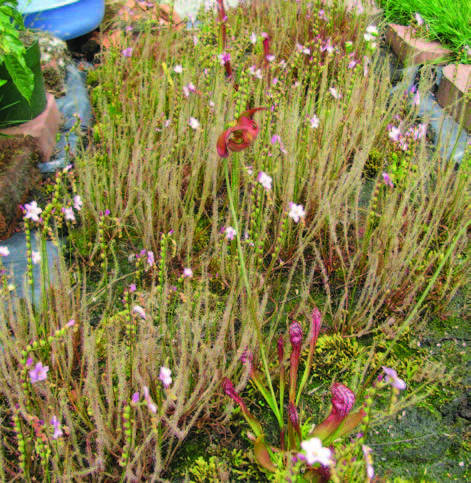
Figure 7: Drosera x californica ‘Portland Sunrise’ taking over a back yard bog near Portland, Oregon.

Figure 8: Flower of Drosera x californica ‘Portland Sunrise’. 11-photo composite image by John Brittnacher.
|
